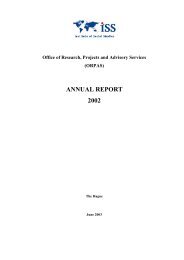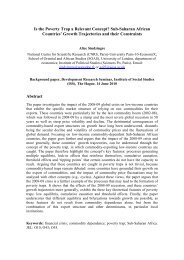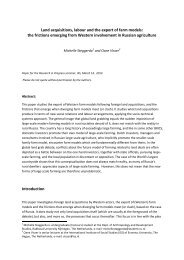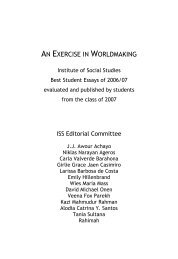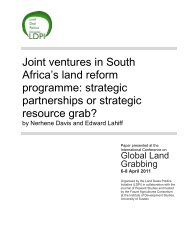AN EXERCISE IN WORLDMAKING 2009 - ISS
AN EXERCISE IN WORLDMAKING 2009 - ISS
AN EXERCISE IN WORLDMAKING 2009 - ISS
You also want an ePaper? Increase the reach of your titles
YUMPU automatically turns print PDFs into web optimized ePapers that Google loves.
8 S<strong>AN</strong>JUKTA CHAUDHURI<br />
Indian National Movement – Role and participation of ‘Youth’<br />
The nascent signs of ‘youth activism’ in India can be traced back to the period of Freedom<br />
Struggle for Independence * . Certain landmark events in the countries freedom movement<br />
witnessed a large scale participation of students. The dissatisfaction towards the British<br />
system of education which aimed at providing basic knowledge and skills on the English<br />
language focused at recruiting the ‘young Indians’ to clerical posts for civil services stimulating<br />
student agitation. Mahatma Gandhi’s Non-Cooperation Movement (1920) mobilized the<br />
students to participate in boycotting British colleges and universities. Students actively participated<br />
in road demonstrations, protest marches and boycott campaigns (Altbach, 1970:<br />
238).<br />
A large number of youth conferences were held and coalitions, leagues, federations<br />
formed both at the national and regional level e.g. All Bengal Students’ Association which<br />
claimed a membership of 20,000 in 1929 (ibid). Similarly the Quit India Movement 1942<br />
was regarded as a mass student upheaval where approximately 10 percent of the student<br />
population participated; even those who were passive expressed their support in boycotts,<br />
picketing of shops, staging street demonstrations against British administration, allied in<br />
clandestine activities with nationalist leaders and also took up leadership roles. Although<br />
the Quit India Movement remained unsuccessful in ousting the British, it laid the foundation<br />
of ‘National Liberation Movement’ (Altbach, 1970: 241).<br />
*<br />
The history of Indian Freedom Struggle spans over the period from (1857-1947). However<br />
for the purpose of this paper the time period from Partition of Bengal (1905) to the Indian<br />
Independence (1947) has been taken into consideration.<br />
portive role as compared to that of young men. The role of young women<br />
was essential to build up mass movements and was more integrationist.<br />
They too were swayed by the nationalistic feelings rather than rooting<br />
their identity as ‘youth’ and as ‘equal participants’ to young men. This<br />
was more so because of the male connotation in the perception of<br />
‘youth’. It has been argued by some scholars that the traditional models<br />
of ‘political behavior’ have been built on ‘androcentric model of the public<br />
sphere’, ‘the political’, which predictably eliminate women and related<br />
issues. Feminists on the other hand have also established that ‘personal is<br />
political’, whereby it is the unequal status of women within the private<br />
domain which transcends to define her position in the male-dominated




